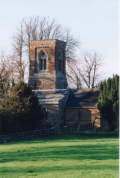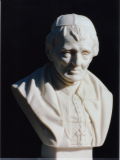Millennium Project
J H Newman and Deddington
Brian Carter, May 2002
 Cardinal Newman
Cardinal NewmanJohn Henry Newman's first visit to Deddington was almost certainly on Saturday May 1st 1823, although passing through describes more accurately the nature of the occasion. Newman had left Oxford that day to visit an old student friend from Trinity College, George Smalley: Smalley was a curate in Banbury and had recently married. Evidently this visit to Banbury was something of an event for Newman as he planned to make the journey on horseback and he did not see himself as a natural horseman. He referred to the forthcoming trip in a letter to his mother, and mentioned the twenty three or four miles that separated Banbury from Oxford; and writing to his sister Jemima a little over a week after his visit, he once again referred to his "expedition" to Banbury. He was evidently rather pleased with himself and relayed to Jemima how, when he had described to his friends his lengthy horseback ride to Banbury, they had been gratifyingly impressed with his exploit. In his letter to her, he also noted that he "returned to Oxford to Breakfast, setting out at six o'clock and being exactly three hours - it is between 22 and 23 miles, ..."
The Deddington that Newman would have ridden through in 1823 is very similar to that of today. Many of the buildings that line New Street and High Street remain much as they were one hundred and eighty years ago. Then as now any traveller can glance along The Tchure, which connects the High Street to the Market Place, and look towards the handsome tower of the parish church which creates such a picturesque focal point. Deddington's population of around 1800 people is about the same as in Newman's time.

Later in 1823, Newman recorded the first of many visits he made to Over Worton, a small village about four miles from Deddington. Over Worton was a parish with a strong evangelical tradition which had been consolidated by the ministry of Daniel Wilson [1778-1858], who was curate there from 1807-12 while also Vice Principal of St Edmund Hall, Oxford. Daniel Wilson later established himself as one of the leading evangelicals in London before his consecration as Bishop of Calcutta in 1834, a position he held until his death in 1858.
It was in 1823 that the Reverend Walter Mayers [1790-1828] was appointed curate of Over Worton, and on account of his friendship with Mayers Newman became a regular visitor there: in fact, not only Newman himself, but his brothers and sisters as well as his mother stayed from time to time with the Mayers family. Walter Mayers had been Newman's classics master at Dr Nicholas's school in Ealing, and during that time had exercised a profound influence over Newman (which Newman later acknowledged in a characteristic and generous way in his Apologia.) Newman preached the first sermon of his life at Over Worton on June 23rd 1824; and he also preached the funeral sermon following Mayers' unexpected death in 1828.
On July 15th 1824, Newman wrote in his diary, "... rode over to Deddington and dined with Mr Greaves." Like Over Worton, Deddington was a parish with strong evangelical leanings and in Richard Greaves [1793-1870], who was appointed as vicar in 1822, they had found a man with all the desired evangelical credentials. Greaves's appointment may well have had something to do with the fact that he was married to Sophia Wilson, daughter of the incumbent and Patron of Over Worton, and thus brother-in-law to Daniel Wilson. However, the name of Greaves was a familiar one in evangelical circles, and with the arrival of Richard Greaves in Deddington, this small north Oxfordshire village became linked for a time to a wider European dimension of the evangelical movement. The prime mover in this connection was the Reverend John Hill [1786-1855], the acknowledged "standard bearer" for the evangelicals in Oxford and much further afield, and who also succeeded Daniel Wilson as Vice Principal of St Edmund Hall. For various reasons at that time Geneva, and to some extent Lausanne, held a peculiar pulling power for those with evangelical leanings. Richard Greaves had lived in Lausanne for a time: his remarkable sister, Mary Ann Greaves, had settled there for many years, and subsequently at Geneva, and had played her part in the Swiss Réveil [Awakening]. Another brother, James Pierrepont Greaves [1777-1842], played a central role in disseminating in England the ideas of the pioneering Swiss educationalist Johann Heinrich Pestalozzi [1746-1827]. John Hill developed many connections amongst a diverse group of like-minded individuals with many of his continental contacts in the 1820s coming via Richard Greaves of Deddington. Greaves also possessed a valuable asset: he was fluent in German, an uncommon accomplishment for an Anglican clergyman of that time. His familiarity with the language was called upon at a time of tension between the Church Missionary Society and the Basle Missionary Institute.

It was only natural that the young twenty three year old Newman would come across and work with the well established and equally zealous Vice Principal of St Edmund Hall, John Hill. A few years later Newman became co-secretary with Hill of the Oxford branch of the Church Missionary Society, but in 1830 their ways parted over the organisation of the branch with Newman feeling that the branch had become an exclusively evangelical body, which he objected to, and for his dissent he was voted out of office.
In 1825, however, there were no such strains and on 19th September Newman and Hill visited Deddington together. They "dined with Mr Greaves …", attended a Church Missionary Society meeting where, as Newman noted in his diary, he delivered the "first speech I ever made." It is not known where the meeting was held: it could have been in the Town Hall or perhaps in some part of the Church. The text of the speech was preserved by Newman and is printed in the Appendix to Volume I of his Letters and Diaries.
Newman's diaries cover the years from 1824 to 1879, but unfortunately there is a gap between July 1826 and March 1828, so there is no further definite evidence that he revisited Deddington. As well as having Greaves as their vicar, Deddington also had an evangelical curate in John Hughes [1787-1860], a Welshman who had been ordained despite not possessing a university degree, which was one of the usual pre-conditions for ordination. Hughes was evidently an outstanding preacher and, according to his memoir, people regularly came from Oxford to hear him, including Newman, it is suggested. Hughes departed from Deddington in 1827 for Aberystwyth and in time was appointed Archdeacon of Cardigan. A modern historian has written of Hughes that in Wales Hughes "was regarded as one of the great preachers of his time."

John Henry Newman's original claim to distinction and fame lay in his position as the driving force behind the Tractarian/Oxford Movement of the 1830s. This familiarity with the Tractarian period has somewhat overshadowed his life before that time, as well as tending to diminish the stature of many of the figures of the decade of the 1820s by their being compared with the leading figures of the Oxford Movement. This latter perception fails to do justice to the influence and importance of the people and movements that evolved from the predominantly radical evangelical circles with which Newman was familiar at that time. What is incontestable is that John Henry Newman had been judged during his lifetime as one of the greatest Churchmen that England every produced, and his posthumous reputation has, if anything, been enhanced and has extended that assessment of him.
It should be a matter of interest and some satisfaction to residents of Deddington that some among their predecessors heard the first speech that Newman ever made, and thus bore witness to the very start of Newman's public life, which began with his speech on September 19th 1825 in Deddington.
Brian Carter's excellent booklet (1.7 Mb pdf) on Newman at Deddington is available by clicking on this thumbnail image. We would like to express our sincere thanks to Brian for allowing use of his material.

